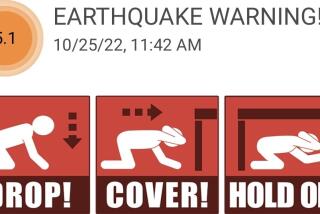Officials Aim to Improve Amber Alerts
After five child-abduction alerts in California in the last 10 days--two of them false alarms--state officials, law enforcement officers and broadcasters gathered Friday to hammer out ways to improve the system.
The so-called “Amber alert” network, which posts information about an abducted child on radio, TV and digital freeway signs, has been widely praised for helping in the rescue of two kidnapped Antelope Valley teenagers last week. But the program, launched just two weeks ago, also needs debugging.
“We spent a lot of time going over its defects,” Gov. Gray Davis said at a Los Angeles news conference after the meeting. “We want to make it work better.”
The fine-tuning process will take three months, he said. Ideas from the meeting included standardizing the alert’s format and providing translations in Spanish, Chinese and other languages.
Some participants said alerts should be restricted to kidnappings by strangers and exclude custody-battle abductions, unless the child faces harm.
“The real danger of this system is, if you use it all the time, it loses its effectiveness,” said Tom Marshall, spokesman for the California Highway Patrol. “You can’t interrupt broadcasts three times a day.”
Victim advocates say such fears are overblown.
“Is it not worth it to save a child’s life?” asked Jenni Thompson, spokeswoman for the Polly Klaas Foundation in Petaluma.
Two weeks ago, Davis kicked off the California Child Safety Amber Network, named after a Texas girl who was abducted and killed in 1996. Davis said he would sign a bill by summer’s end that would require law enforcement organizations to use the system. It’s now voluntary.
Authorities activated an Amber alert for the first time on July 31 in Northern California, when someone reported having seen a child being shoved into a van, according to the CHP. Soon, freeway signs in the San Francisco Bay Area began flashing alerts. They stopped an hour or two later, when police learned the teenager was a runaway and the van belonged to his group home.
The second alert, and the only statewide one so far, came Aug. 1 in the Antelope Valley case. Though the system generated calls that led to the girls’ rescue, it also was criticized because it took five hours to activate. Law enforcement’s goal is 30 minutes. Later that day, a San Diego carjacking prompted an Amber alert in San Diego and Imperial counties. The child was later found in Tijuana.
On Aug. 2, an Amber alert again was issued in the Bay Area after a 12-year-old girl in a Chinese student tour group was reported to be missing. The alert was canceled after she surfaced with her family.
The next day in Sacramento, a sighting of a girl being grabbed triggered another Amber alert in Northern California. Within hours, she was found unharmed at home. Authorities believe the alert might have discouraged her alleged abductor.
The two false alarms show the need for higher alert standards, said Assemblyman George Runner (R-Lancaster), who wrote the pending Amber alert bill.
“It’s not meant to be an announcement for any missing person,” Runner said, citing the case of the Chinese girl as one that police should have investigated further. “They weren’t even sure she was abducted. She was just missing, and all of a sudden they had freeway signs up.”
More to Read
Sign up for Essential California
The most important California stories and recommendations in your inbox every morning.
You may occasionally receive promotional content from the Los Angeles Times.










